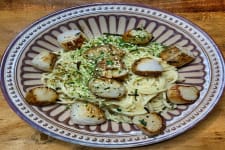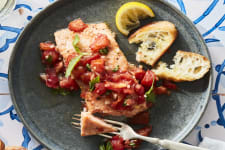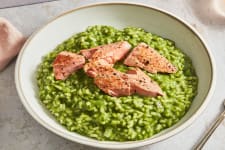Summer brings with it an abundance of fresh herbs. Markets, grocers, and backyard herb gardens are filled with fragrant bouquets of tender green things, of all shapes and sizes.
Luckily, fresh fish and fresh herbs go so well together and whether you’re cooking with wild-caught fish or shellfish, don’t hesitate to use a heavy hand when integrating herbs into your recipe. Here are some wonderful ways to make the most out of herbs when making wild-caught seafood:
Chop Them
When you have lots of tender herbs on hand, you don’t need to do much more than chop them to put them to good use with wild-caught seafood. Literally, you can simply coat a fillet of fish with chopped herbs and olive oil — no measuring or marinating requires — then bake until done.
Or you can pan sear a fillet in butter, remove the fish when it’s cooked through, turn down the heat, and then toss in a handful of chopped herbs to infuse into the butter for a minute or two for a high-flavor, low-maintenance sauce.
You don’t even have to add the herbs to your seafood to get the most out of your wild-caught meal. For a healthy lunch al fresco, a bright herb salad makes for a light but flavorful side dish. This recipe from Bon Appetit for an herb salad is literally a plate of chopped herbs dressed with fresh lemon juice and olive oil, with the addition of onion and ribbons of carrots.
Cure Them
Dill, parsley, tarragon, cilantro, fennel fronds, chives — all of these fresh and abundant green herbs are excellent candidates to flavor a fillet of cured wild salmon. It’s really up to you what, depending on what flavors you’d like to impart on your gravlax. Dill, of course, is a classic. But cilantro and chives pair up nicely, as do tarragon and mustard seeds. Fennel fronds could work well with some citrus zest. Check out our blog post for a basic guide on how to make gravlax.
Freeze Them
Or, you could take a cue from us and stash your herbs in the freezer for up to a month or so; storing them for longer than that isn’t a bad thing, but the flavors will certainly lose some of their potency over time.
You’ll want to process your herbs first so that they can be frozen into a freezer tray. This way, you won’t have to defrost an entire container of herbs; you can simply access a frozen cube or however many you need for your recipe. Thaw these gently over low heat when you’re ready to use them, or to make things even easier, move them into the refrigerator in a small dish to thaw at the same time you’re defrosting your seafood.
Chimichurri, a green and garlicky blend of fresh parsley and oregano (and sometimes with the addition of some basil or cilantro), does double duty as a marinade and as a sauce to drizzle on or dip into. While practically anything tastes delicious with chimichurri, it’s excellent for a mild and meaty fish like Pacific halibut or Pacific cod. It also looks beautiful on a fillet of sockeye.
A non-traditional pesto made from cilantro and pepitas makes use of any excess cilantro you might have leftover from taco night. Making a batch of cilantro pesto will ensure that you can use the entire bunch before it wilts, and is flavorful enough to dress up a simply seasoned, pan-seared fillet of fish. Of course, cilantro pesto is also a great topping for tacos, too. Try this recipe from Serious Eats.






